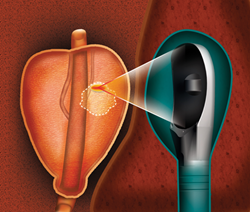High-performance Imaging Treatment for Prostate Cancer Patients
HIFU (Robotic High Intensity Focused Ultrasound) — only available in Tennessee at Erlanger Hospital — uses high performance imaging technology, which allows the urologists at Erlanger Urology to precisely target prostate cancer with pinpoint accuracy while preserving the healthy tissue around the prostate.
What is Robotic High Intensity Focused Ultrasound (HIFU)?

This robotic precision makes it possible to destroy cancerous cells without damaging your healthy tissue and allows for safely repeating the process as needed. Ultrasound waves pass through layers of healthy tissue without causing harm until they reach their target.
Advantages of Robotic HIFU treatments
Robotic HIFU is the ideal treatment tool, since it allows the doctor to target just the diseased part of the prostate for the optimal preservation of quality of life. This latest HIFU medical device is dedicated to focal therapy. Real-time imaging allows for precise treatment in one session under general anesthesia and is repeatable, if necessary, with a low risk of side effects.
Other benefits to utilizing Robotic HIFU treatments include:
- Non-invasive procedure – no blade, no scar, no radiation or incision
- Low risk of side effects like incontinence and erectile dysfunction
- Helps preserve quality of life with minimal time away from work and leisure activities.
- Precise targeting of cancerous tissue, leaving healthy tissue unharmed
- Most patients will return to normal activities within 48–72 hours after this outpatient procedure.

